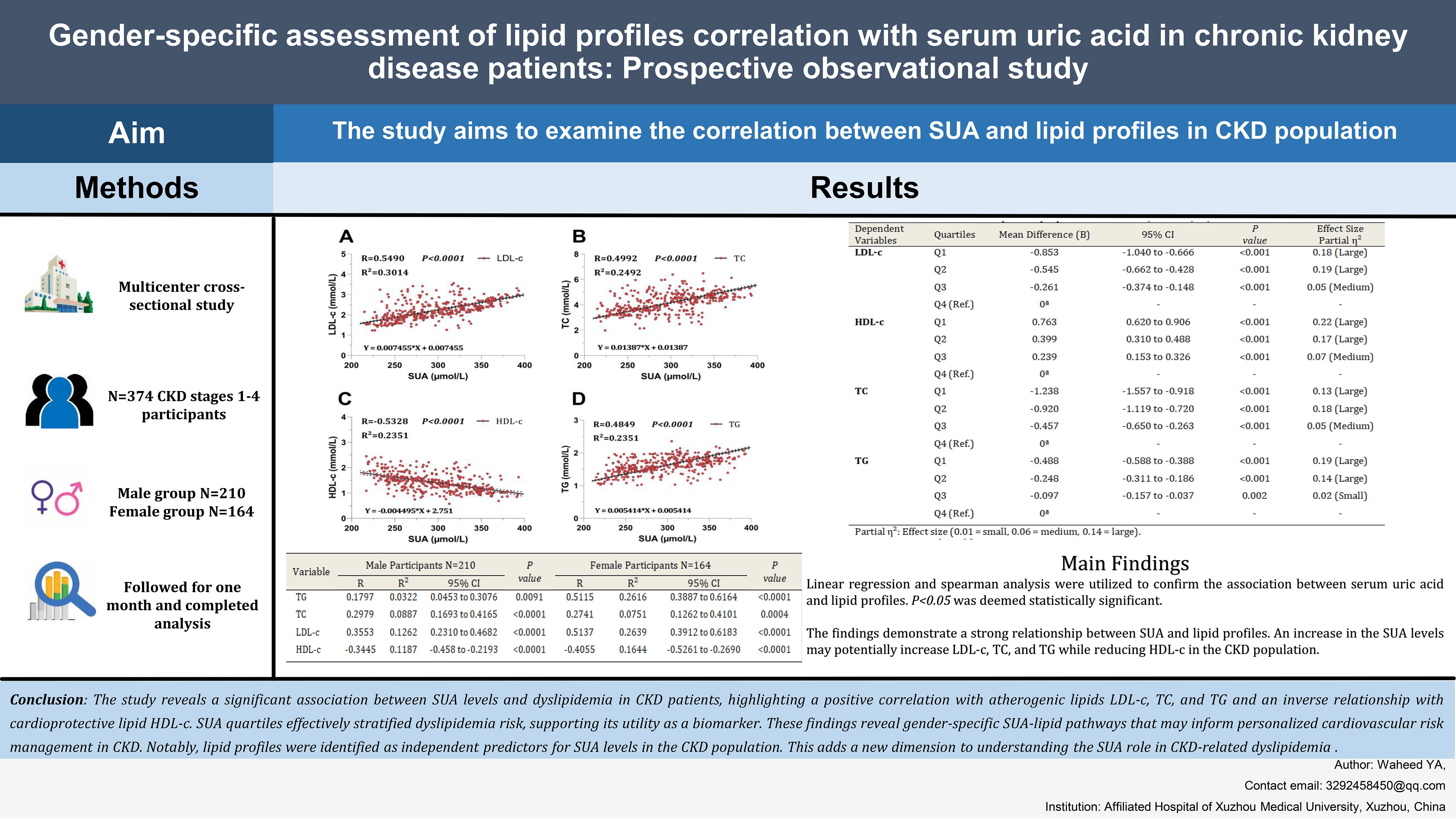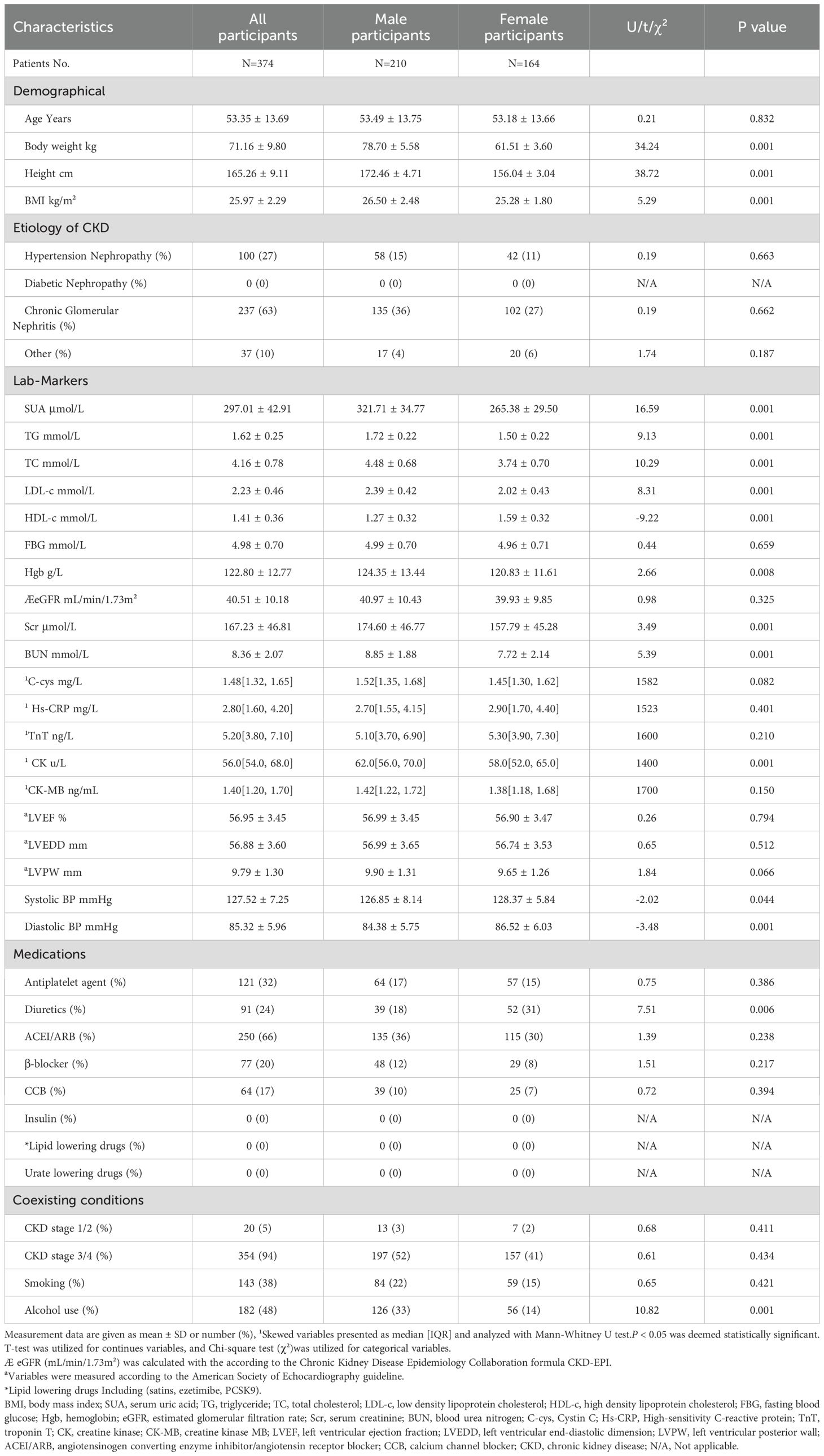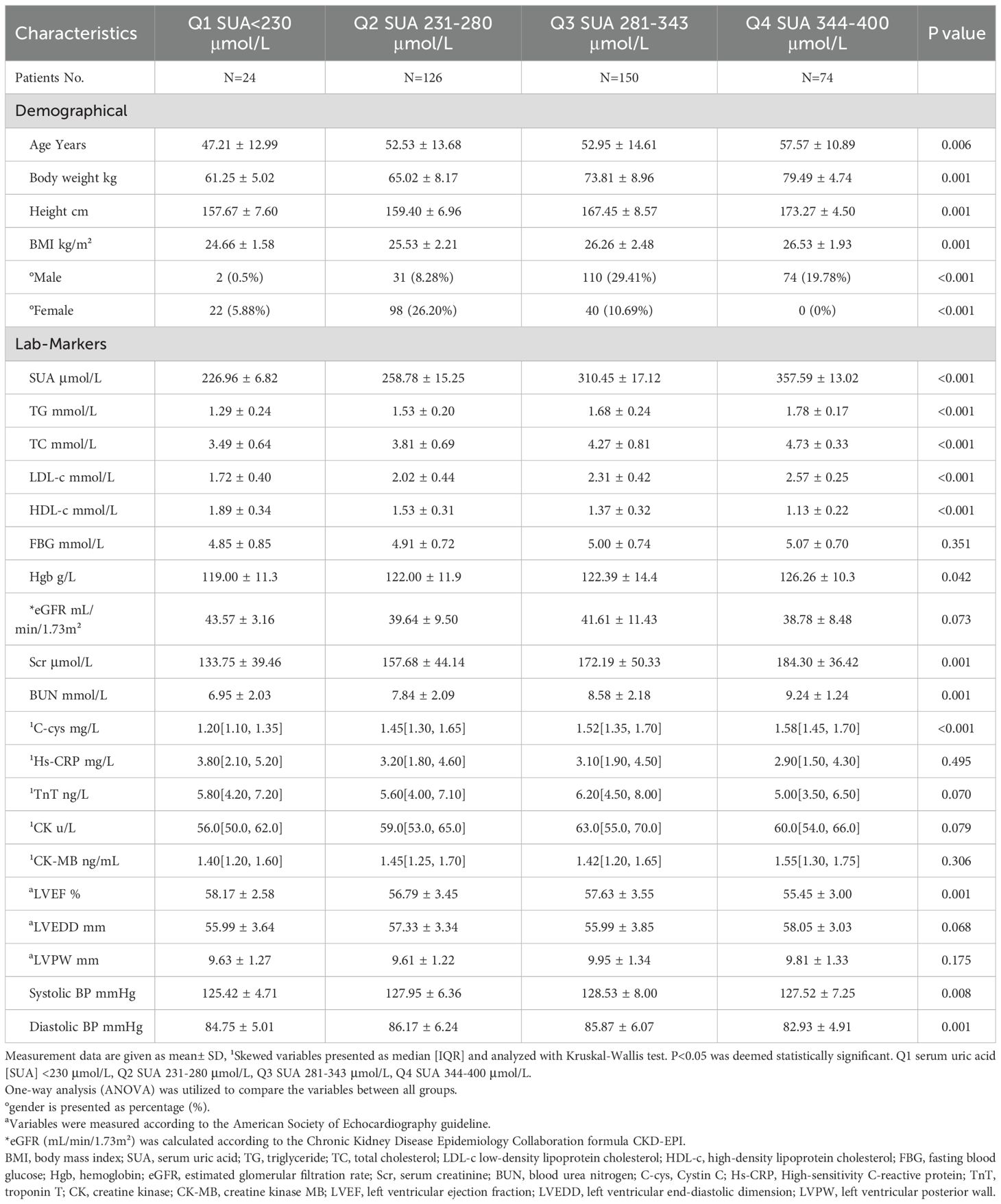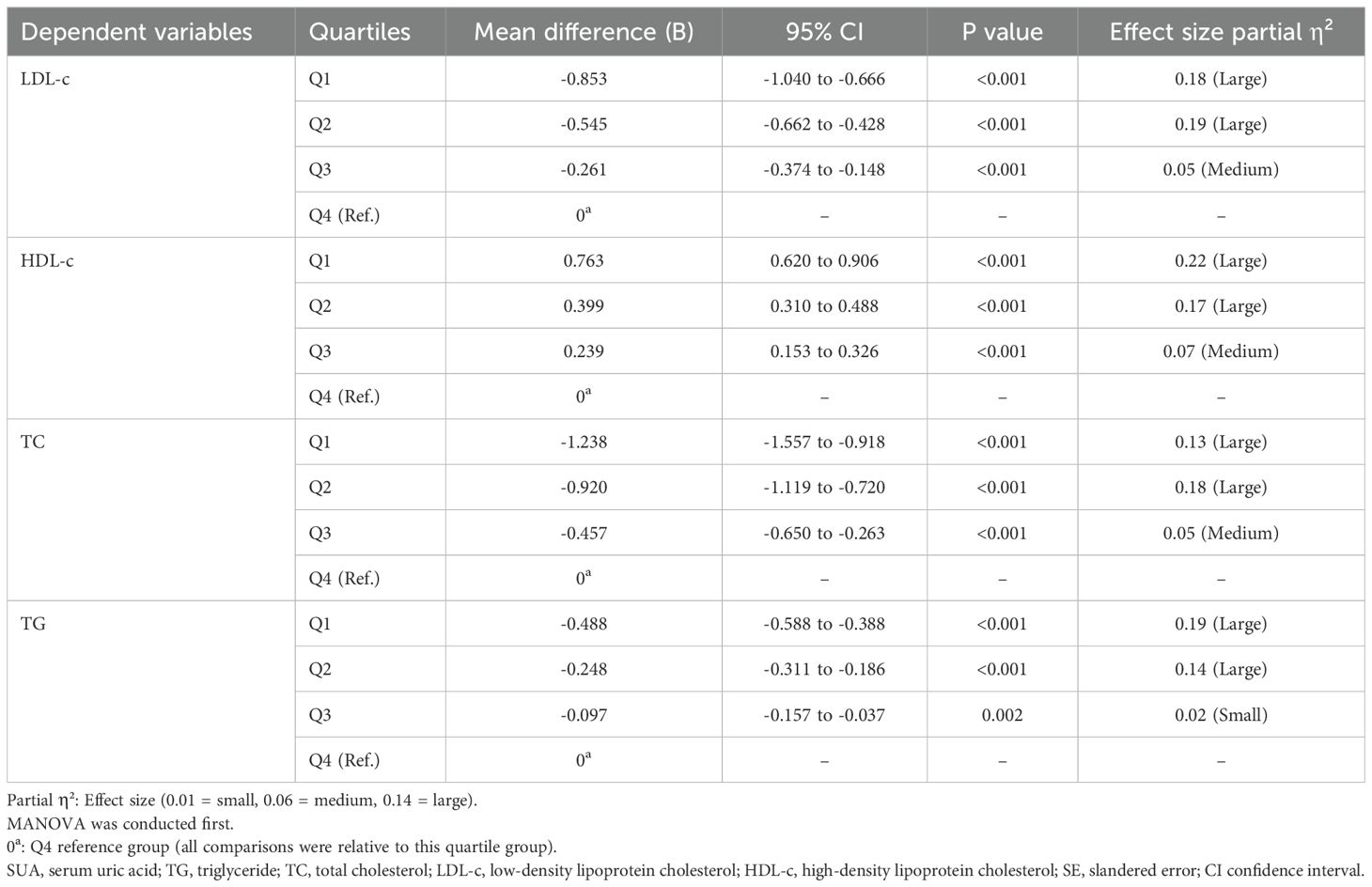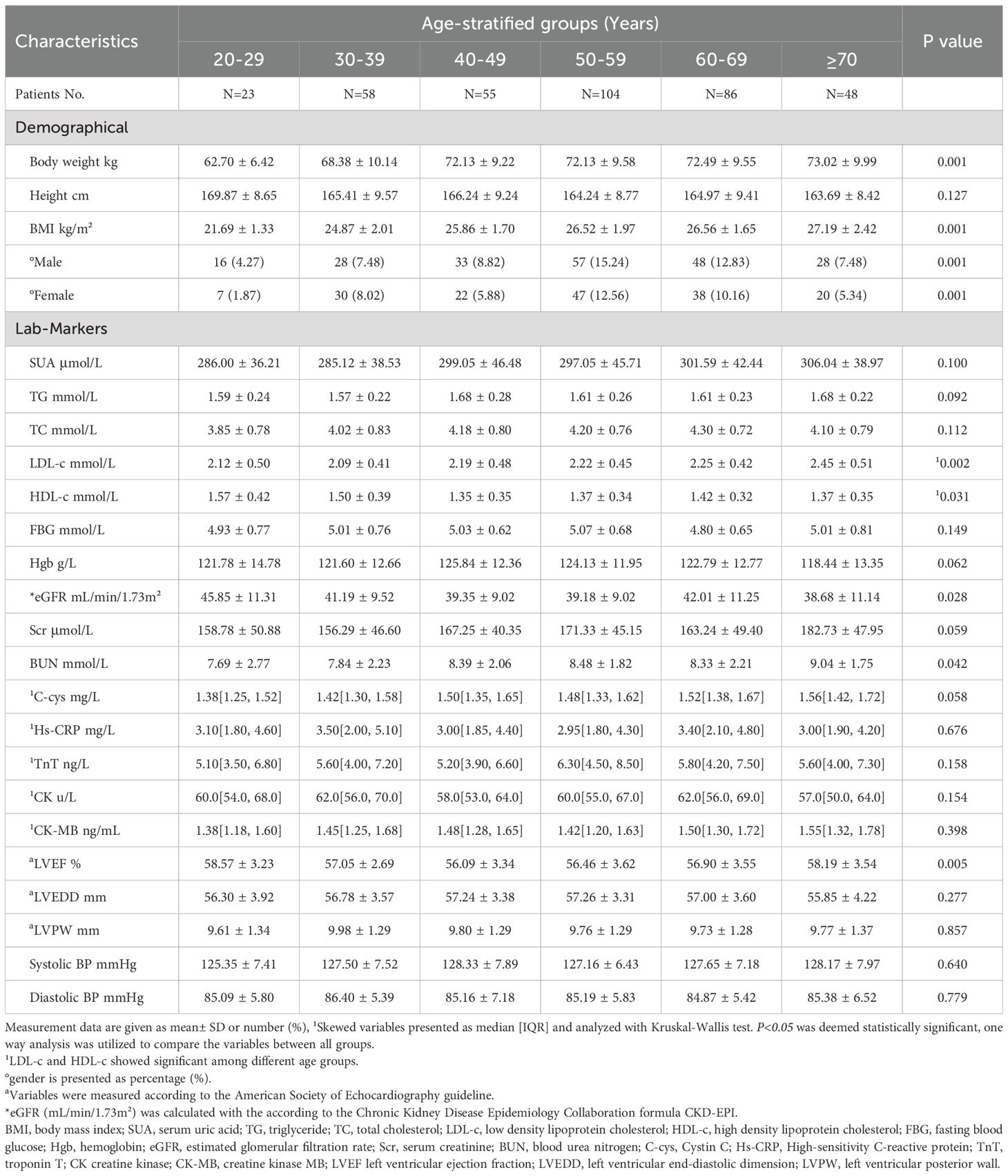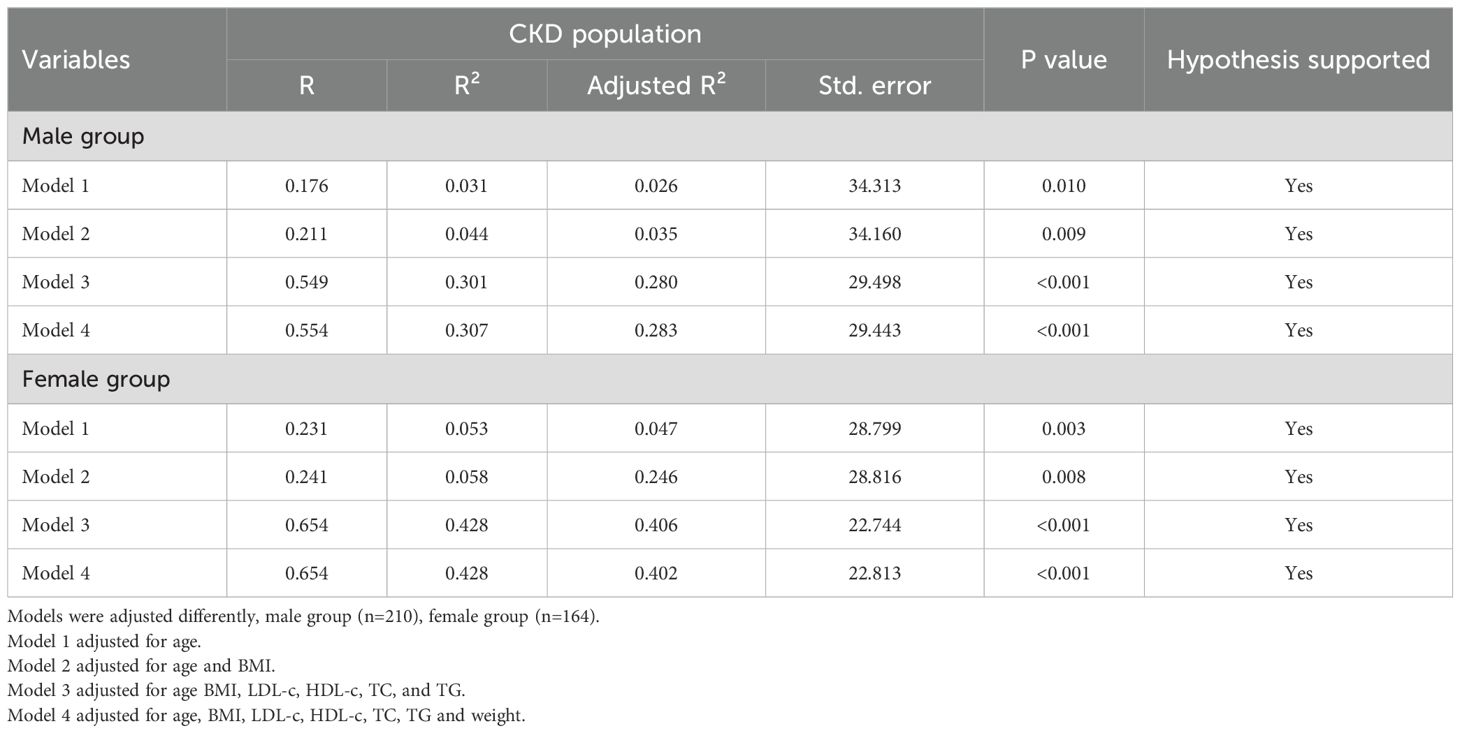- 1Department of Nephrology, Affiliated Hospital of Xuzhou Medical University, Xuzhou, China
- 2Clinical Research Center for Kidney Disease of Xuzhou Medical University, Xuzhou, China
- 3Department of Nephrology, Fengxian People’s Hospital, Xuzhou, China
- 4Department of Nephrology, the Second Affiliated Hospital of Xuzhou Medical University, Xuzhou, China
- 5Medical College, University of Fallujah, AL Anbar, Iraq
- 6Central Michigan University College of Medicine, Mount Pleasant, MI, United States
- 7Medical College, Xuzhou Medical University, Xuzhou, China
- 8Department of Internal Medicine and Diagnostics, Xuzhou Medical University, Xuzhou, China
Background: Serum uric acid (SUA) serves as an important marker for assessing kidney function in chronic kidney disease (CKD) patients. Emerging reports suggest a potential relationship between SUA and dyslipidemia. The study aims to examine the correlation between SUA and lipid profiles in CKD population.
Method: We conducted a multicenter, prospective observational cross-sectional study, enrolled n=374 stages 1/4 CKD participants were stratified by gender into (n=210 males and n=164 females). Using a multistage stratified sampling method based on age and SUA to examine the differences among groups, Spearman’s correlation and linear regression analysis were utilized to study the association between SUA and lipid profiles, and multivariate analysis to determine the effect of SUA quartiles on multiple dependent variables collectively.
Results: LDL-c was positively correlated with SUA levels, with Spearman’s correlation coefficients of R=0.3553 in males and 0.5137 in females (both with P<0.0001). TG also showed a positive correlation, with coefficients R=0.1797 in males and 0.5115 in females (P<0.0091 and P<0.0001, respectively). Similarly, TC showed a positive correlation R=0.2979 in males and 0.2741 in females (P<0.0001 and P<0.0004, respectively), while HDL-c showed an inverse correlation with SUA correlation coefficients R=-0.3445 in males and -0.4055 in females (both with P<0.0001). The age-stratified analysis indicated that LDL-c was higher in individuals aged ≥70 compared to younger groups (P<0.002), while HDL-c was higher in the 20–29 age group; with (P<0.031). Post-hoc univariate tests revealed significant between quartile differences for all lipid variables (all P ≤ 0.05).
Conclusion: In CKD population, SUA levels were positively associated with LDL-c, TC, and TG, while inversely associated with HDL-c. Additionally, lipid profiles were identified as significant predictors of SUA levels. Furthermore, the graded associations of SUA quartiles with lipid profiles suggest that SUA may be employed as a biomarker of dyslipidemia risk among this population.
Introduction
The end-product of purine metabolism is serum uric acid (SUA), produced in the liver and ultimately excreted via the kidneys throughout the body (1–3). Mostly, it is formed by endogenous synthesis with less being sourced externally (4). Abnormalities in either excessive production or under-excretion define the causes behind hyperuricemia (HUA). The definition for HUA diagnosis in China states the cut-off value for SUA concentration >420 μmol/L, specifically applied to male and female patients (5). According to one meta-analysis, the estimated aggregated prevalence of HUA in mainland China was found to be 13.3% (95% CI: 11.9-16.4%) (6).
SUA’s association with kidney stones is well established and significantly correlates with chronic kidney disease (CKD) (7). HUA is frequent in patients with CKD and constitutes an increase in SUA level as a result of a decrease in the estimated glomerular filtration rate (eGFR). The considered basis for such an association may be the crystallization of urate within renal tubules or in the extrarenal system, with a special emphasis on obese individuals (8). Recent studies have further supported the relationship between elevated SUA levels and initiation and progression of CKD, as well as increased cardiovascular diseases (CVD), hypertension (HTN), diabetes mellitus, metabolic syndrome, and cognitive decline (9, 10). A meta-analysis showed that the increased SUA concentrations were significantly linked with the development of metabolic syndromes, regardless of individual study characteristics (11).
Several studies have investigated this phenomenon, yielding significant insights into the dynamic relationships between SUA and lipid profiles. HUA is commonly recognized as a key risk factor for dyslipidemia. Various studies have shown a positive correlation between SUA levels and lipid profiles in adult populations (12). For instance, a study conducted in Bangladesh revealed a significant positive relationship between SUA levels and lipid profiles among adults (13). Similarly, research by Peng et al. (14) in the US found a strong correlation between lipid profiles and SUA levels in the adult population. In addition, high levels of SUA were also considered a risk factor for hypertriglyceridemia (15). However, a recent study on 409 obese Chinese with BMI of >24 kg/m2 conducted to explore this relationship revealed that SUA has no close association with metabolic diseases such as HTN and dyslipidemia (16). Therefore, this close association has not been fully uncovered and it needs further research to establish a better understanding of this relationship. Moreover, Most of those studies have been conducted in different populations but less we know about studies conducted on the CKD population which encourages conducting research among this type of population.
CKD is not simply a renal condition; it is a multifaceted systemic metabolic disorder marked by specific changes in lipid and SUA homeostasis that significantly differ from the patterns seen in the general population. These metabolic disturbances unique to CKD are of clinical importance, as they independently accelerate the decline of renal function and increase cardiovascular morbidity, which is the primary leading cause of death in this population. The components of metabolic syndrome (MetS) are notably prevalent among CKD patients, impacting around one-third of this population (17), and their existence is a strong predictor of progression to end-stage kidney disease (ESKD). In particular, MetS is associated with a 2.31-fold increased risk of CKD progression when compared to individuals without MetS (18), with Cox regression analyses validating it as an independent risk factor for the initiation of renal replacement therapy, in conjunction with proteinuria and hyperphosphatemia (17).
In this metabolic context, SUA stands out as a critical yet frequently underestimated factor. Recent large-scale cohort investigations establish SUA as the foremost predictor of incident CKD among the components of MetS (adjusted HR=1.85), outpacing the risks associated with HTN (HR=1.69) or hyperglycemia (HR=1.65) (18). This correlation is mechanistically sound, as HUA incites renal inflammation, endothelial dysfunction, and oxidative stress within the renal system, thereby directly facilitating tubulointerstitial fibrosis and glomerulosclerosis. Additionally, the metabolic relationship between SUA and lipids in CKD reveals unique traits; non-targeted metabolomics uncovers significant disruptions in glycerophospholipid metabolism pathways in CKD patients with simultaneous HUA, differentiating them from either condition alone and indicating a synergistic nephrotoxic impact. Crucially, these associations display gender-specific characteristics; the elevation of SUA correlates with negative cardiac remodeling in female CKD patients, but this is not the case for males (19). Meanwhile, HDL-c’s protective effects on the kidneys show a continuous linear relationship in women, contrasting with a threshold effect in men (20). Given that standard lipid-lowering treatments often provide insufficient cardiovascular protection in CKD, understanding the SUA-lipid relationship could identify innovative therapeutic targets to alleviate metabolic toxicity and disrupt the harmful cycle of renal deterioration. Thus, examining the gender-dimorphic links between SUA and atherogenic lipid fractions (LDL-c, TG) alongside protective HDL-c in CKD is not only physiologically compelling but also crucial for formulating precision-medicine strategies for this vulnerable population.
These findings suggest that elevated SUA levels may contribute to dyslipidemia in CKD patients. Mechanistically, these changes may occur via various pathways in UA-dyslipidemia interaction. The activation of insulin resistance as a possible mediator of SUA could lead to increased TG synthesis and decreased lipoprotein lipase activity, with the potential to block cholesterol metabolism in the liver accompanying TC elevation. In addition, the activation of inflammatory pathways whereby SUA affects lipid metabolism is variously defended, thus aggravating lipid metabolism pathologies in CKD. Herein lies the importance of the relationship between SUA and lipid profiles in CKD patients toward the effective management of dyslipidemia in this population. Interventional measures addressing lifestyle changes through dietary modification, and weight loss, together with drug therapy to lower SUA in HUA patients may improve lipid pattern status and decrease the risk for cardiovascular problems in patients suffering from CKD.
Understanding the relationship between SUA and lipid profiles in CKD is crucial for uncovering potential metabolic interactions and informing clinical managements. To address this gap, we conducted our research to explore this relationship between SUA levels and lipid profiles in the CKD population.
Methods
Study design and participant eligibility
We conducted a multi-center, prospective observational study, involving 374 non-dialysis stage 1/4 CKD patients from December 2023 to March 2025. The study was carried out in three tertiary hospitals located in Xuzhou, China: Xuzhou Medical University Affiliated Hospital, the Second Affiliated Hospital of Xuzhou Medical University, and Fengxian Peoples Hospital. Standardization was achieved through: 1- Centralized training for site investigators on uniform protocols; 2- Stringent quality control with external validation; 3- A steering committee overseeing biweekly patient enrollment and endpoint adjudication. Centralized eligibility verification guaranteed consistent CKD staging. This design utilized diverse catchment areas while reducing site-specific bias; we performed comparisons of baseline characteristics and outcomes across the participating centers and found no significant differences in lipid profiles and SUA. Throughout sensitivity analyses, which included the three centers, we consistently found that our results were similar. Eligible patients were divided into male group n=210 and female group n=164. Patients were healthy, and no severe CVD was observed. CKD was diagnosed per KDIGO criteria (21) with confirmed eGFR <60 mL/min/1.73m² for ≥3 months. Any patient with HUA which defined as SUA >420 μmol/L, according to the Guidelines for the Diagnosis and Management of HUA in China, were excluded (5) to isolate SUA-lipid relationships in non-HUA populations, recognizing this may limit generalizability. Inclusion criteria were as follows [1] Xuzhou residency ≥12 months; [2] Age 20–80 years; [3] CKD stages 1/4; [4] No urate-lowering/statin therapy for ≥3 months; [5] No severe cardiac history. Exclusion criteria were [1] patients undergoing dialysis therapy, due dialysis therapy can alter the level of SUA and lipid profiles, [2] pregnancy and lactation period, [3] patients taking drugs that affect SUA concentration and lipid metabolism, [4] patients with severe cardiovascular and neurological complications, [5] patients with gout and those undergoing anti-gout treatment and immunosuppressive therapy, [6] severe liver disease, [7] patients with missing data on SUA and lipid profiles and those who are not fit to participate in the study, [8] diabetic patients were excluded, no cases were enrolled due to high comorbidity burdens affecting eligibility. Patients were followed for one month to observe if they are suitable for enrolment. Participants in the study were receiving their conventional therapy for CKD and no interference with their medication administration. The study protocol was approved by the scientific research ethics committee of the Faculty of Nephrology, Affiliated Hospital of Xuzhou Medical University project ethics number (XYFY2024-KL642-01) and was registered on the Chinese Clinical Trial (ChiCTR2500096252), and the study was conducted in accordance with the Declaration of Helsinki. All participants enrolled in the study gave written informed consent and all experiments were performed in accordance with relevant guidelines and regulations.
Sample size calculation
GPower was utilized to calculate the sample size so that a precise estimation of the outcomes could be made and the associations could be detected reliably. For prevalence estimation, assuming a 95% confidence level (Z =1.96), maximum variability (P=0.5), and a 5% margin of error, yielded 385 participants. The enrollment of 374 patients provided a 5.1% margin of error, which can be accepted for cross-sectional studies. For analytical purposes, this sample size provides ≥80% power (α=0.05) to detect clinically meaningful odds ratios ≥2.0 in logistic regression models, assuming a baseline outcome prevalence of 20% and ≤10 predictors. The final sample also accounts for possible missing data and balances feasibility against robust measurement precision and hypothesis-testing power (22).
Diagnostic criteria
Participants’ CKD stages were determined according to their eGFR which was calculated according to the Chronic Kidney Disease Epidemiology Collaboration formula CKD-EPI which is based on serum creatinine levels, gender, and age at the time of enrolment (23). HUA was defined as SUA more than 420 μmol/L in men and 360 μmol/L in females which is a wildly accepted criterion for HUA (24, 25). Patients were classified as diabetic if they had fasting blood glucose (FBG) ≥ 7.0 mmol/L or higher (26). Participants with systolic blood pressure (SBP) ≥ 140 mmHg and diastolic blood pressure (DBP) ≥ 90 mmHg were diagnosed with HTN (27).
Data collection
The patients’ basic information, demographic data, and medical records were collected by our department medical staff at the time of the visit. Clinical variables include age, weight, BMI, height, past and current medical history, medication administration, etiology of CKD, and CVD such as (HTN [defined as BP ≥140/90 mmHg or antihypertensive use], atherosclerosis, heart failure [clinical diagnosis + echocardiographic confirmation], and myocardial infarction) and other diseases, were also collected and confirmed by the medical staff of our departments. Venous blood samples were obtained after a fasting period of 12 hours and were subsequently analyzed within 24 hours using an automated biochemical analyzer (Roche cobas8000). The laboratory variables included: (SUA, μmol/L; measured through enzymatic colorimetry), (eGFR, ml/min/1.73m²; calculated via the CKD-EPI equation), blood urea nitrogen (BUN, mmol/L), serum creatinine (Scr, μmol/L), and lipid profiles that encompassed total cholesterol (TC, mmol/L; determined by the CHOD-PAP method), triglycerides (TG, mmol/L; evaluated using the GPO-PAP method), high-density lipoprotein cholesterol (HDL-c, mmol/L; assessed through a direct enzymatic assay), and low-density lipoprotein cholesterol (LDL-c, mmol/L; calculated with the Friedewald formula when TG <4.5 mmol/L, otherwise measured directly). Echocardiographs were also obtained from participants and were performed by our hospitals specialists, who are experienced technicians using standardized methods to ensure patients has no severe cardiovascular conditions, tests included left ventricular ejection fraction (LVEF), left ventricular end-diastolic dimension (LVEDD), and left ventricular posterior wall (LVPW) to confirm the absence of severe cardiovascular lesions (defined as LVEF<30%, severe valvular disease, or ventricular aneurysms). The variables were collected and measured according to the American Society of Echocardiography guidelines (28, 29).
Statistical processing
All data were processed using the SPSS 26.0 statistical software package. Normally distributed data were presented as mean ± standard deviation, while count data were analyzed using a chi-square test, and skewed variables presented as median [IQR] and analyzed with Mann-Whitney U test/Kruskal-Wallis test. Continuous variables were assessed for normal distribution using both graphical techniques (Q-Q plots in conjunction with detrended normal plots) and statistical assessments (Kolmogorov-Smirnov test for n>50; Shapiro-Wilk test for n ≤ 50). Normality was confirmed if the Q-Q plots displayed a linear configuration of data points along the diagonal, and the statistical tests produced P>0.05. The data were then re-evaluated until the criteria for normality were met. Differences between age groups and SUA quartiles were compared using a one-way analysis (ANOVA) of variance. The correlation between SUA and lipid profiles was analyzed using Spearman’s correlation analysis and linear regression. Multiple regression analysis was utilized to study the risk factors and predictors of SUA. Tukey’s Honestly Significant Difference (HSD) analysis was utilized for comparing group mean differences between quartiles Q1-Q4. Multivariable linear regression models were used to assess SUA-lipid associations, the selection of adjusted variables age, gender, BMI, and lipid profiles followed a predefined dual rationale, by implementing adjustments with interaction to control for confounders, with SUA×gender interaction terms to test effect modification through variance inflation factors (VIFs) were <5, and residual diagnostics. first, clinical relevance inclusion of factors with established biological links to SUA-lipid metabolism in CKD age/gender modify uric acid clearance; BMI influence dyslipidemia pathogenesis; and statistical protocol which includes retention of covariates altering SUA-lipid β-coefficients by ≥10% in univariate screening. Missing data were effectively reduced by strict adherence to protocols: there were no missing SUA or lipid profile measurements due to our exclusion criteria that mandated complete laboratory data. For baseline covariates, we utilized complete-case analysis after verifying that the data were missing completely at random (Little’s MCAR test: χ²=3.21, P=0.78). No imputation was conducted due to the extremely low level of missingness (<0.5% of covariates) and the clinical insignificance of imputing minimally missing demographic information. P values less or equal to <0.05 indicates a statistically significant difference. GraphPad Prism 9 was used to generate graphs.
Results
Characteristics of participants stratified according to gender
Refer to (Figure 1) for the flow chart of the current study. There were 374 participants in the current study, consisting of 210 (56%) males with SUA level of (321.71 ± 34.77μmol/L) and mean age (53.49 ± 13.57 years), and 164 (43%) females with SUA level of (265.38 ± 29.50μmol/L) and mean age (53.18 ± 13.66 years) and the difference was statistically significant between both groups (P<0.001). The male group had a BMI of (26.50 ± 2.48 kg/m²) and the female group had (25.28 ± 1.80 kg/m²) with a statistically significant (P<0.001). The CKD etiology in this population was primarily chronic glomerular nephritis, 135 (36%) in the male group and 102 (27%) in the female group, and HTN nephropathy was found in 58 (15%) in the male group and 42 (11%) in the females group. CKD stages 1–2 was found in 13 (5%) male patients and 7 (2%) female patients with statistically difference (P<0.001). The majority of participants were stage CKD stage 3/4, with 197(52%) male patients and 157 (41%) female patients with statistically significant (P<0.001). For more baseline characteristics, please refer to (Table 1).
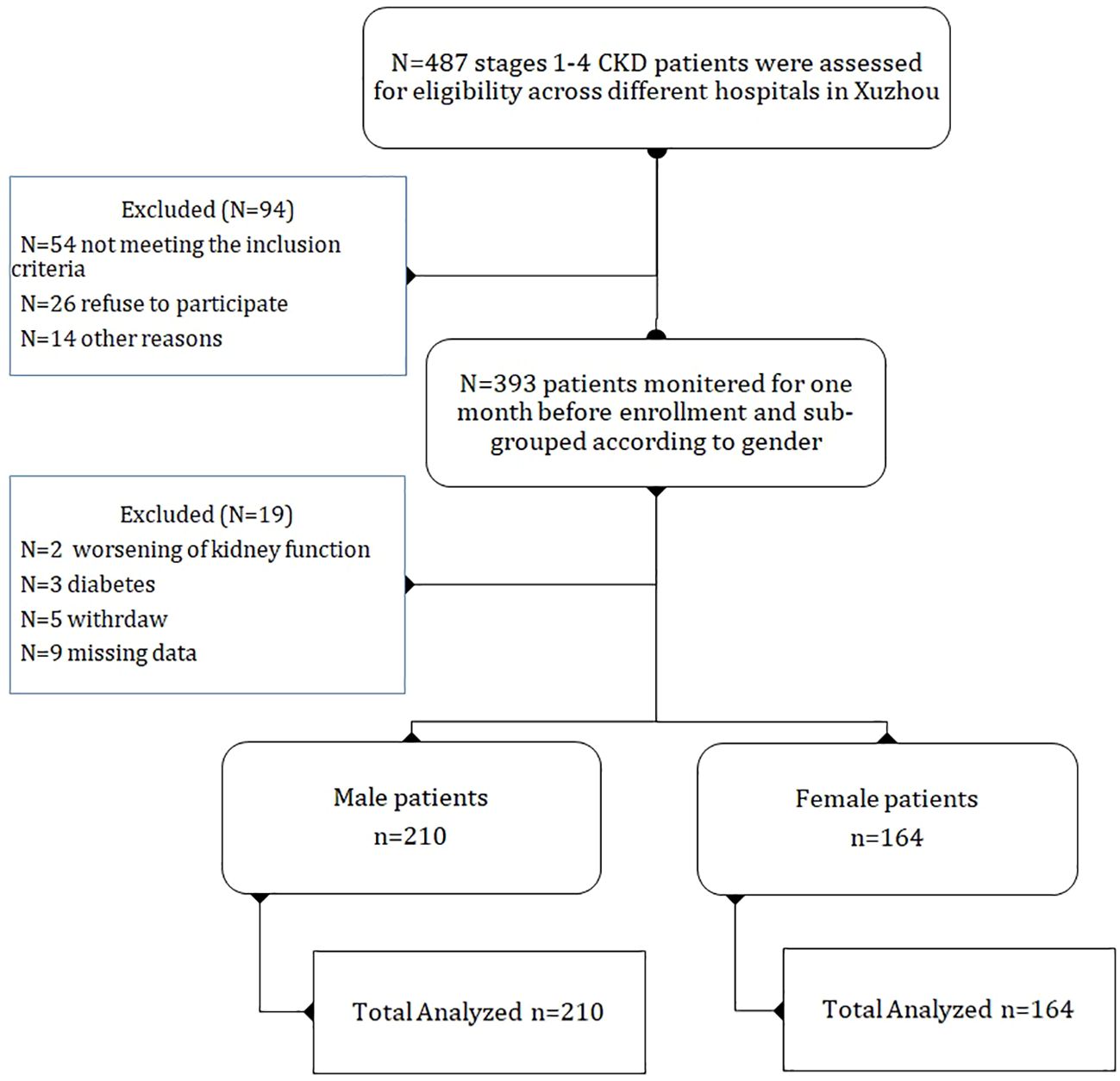
Figure 1. The flow chart of the current study outlines the evaluation process for 487 stage 1/4 chronic kidney disease patients. Patients were evaluated and assessed for eligibility, patients who met the inclusion criteria were monitored for one month before enrollment. After enrollment, further sub-groups were formed based on gender. Patients with any kind of missing data were excluded from the study.
Characteristics of participants stratified according to SUA quartiles
To investigate the association of SUA with lipid profiles, we stratified participants into quartiles based on SUA levels. The quartiles were defined as follows: Q1 (SUA<230μmol/L) including 24 participants (6.41%), Q2 (SUA 231-280μmol/L) included 126 participants (33.68%), Q3 (SUA 281-343μmol/L) included 150 participants (40.10%) and Q4 (SUA 344-400μmol/L) included 74 participants (19.78%). The average age across all quartiles ranged between 47 and 57 years. Interestingly, BMI was highest among Q4 participants compared to other groups with a mean value of (26.53 ± 1.93 kg/m²) which was statistically significant (P<0.001). Q1 had the majority of female participants with 22 (5.88%), and only 2 (0.5%) male participants. Q4 was predominantly composed of male participants with 74 (19.78%) and no female participants in this group. SUA levels were higher in men compared to female participants. In contrast, female participants were predominating in the Q2 group 98 (26.20%). Regarding the lipid profiles, TC, TG, and LDL-c significantly increased from Q1 to Q4, with a statistical significance (P<0.001). As for the HDL-c, it showed a reverse trend by decreasing from Q1 to Q4 with a statistical significance (P<0.001). For more biomarkers and comparisons among the quartile groups, please refer to (Table 2).
Pair-wise comparisons of dependent variables across four quartiles
The analysis of LDL-c levels of Q1 vs. Q2, Q3, Q4 were significantly lower in Q1 compared to higher quartiles all (P<0.05). The largest difference was observed between Q1 and Q4 with mean difference (-0.852, 95% CI [-1.098 to -0.607], P<0.001). Q2 vs. Q3, Q4: LDL-c increased progressively across quartiles, with Q4 showing the highest levels, Q2 vs. Q4: mean difference (-0.545, 95% CI [-0.698 to -0.391], P<0.001). Q3 vs. Q4 difference was smaller but still significant difference was found, mean difference (-0.261, 95% CI [-0.409 to -0.112], P< 0.001) (Figure 2A). These results suggest a graded increase in LDL-c across quartiles, with the highest levels in Q4. This may indicate that individuals in higher quartiles have a greater cardiovascular risk due to elevated LDL-c.
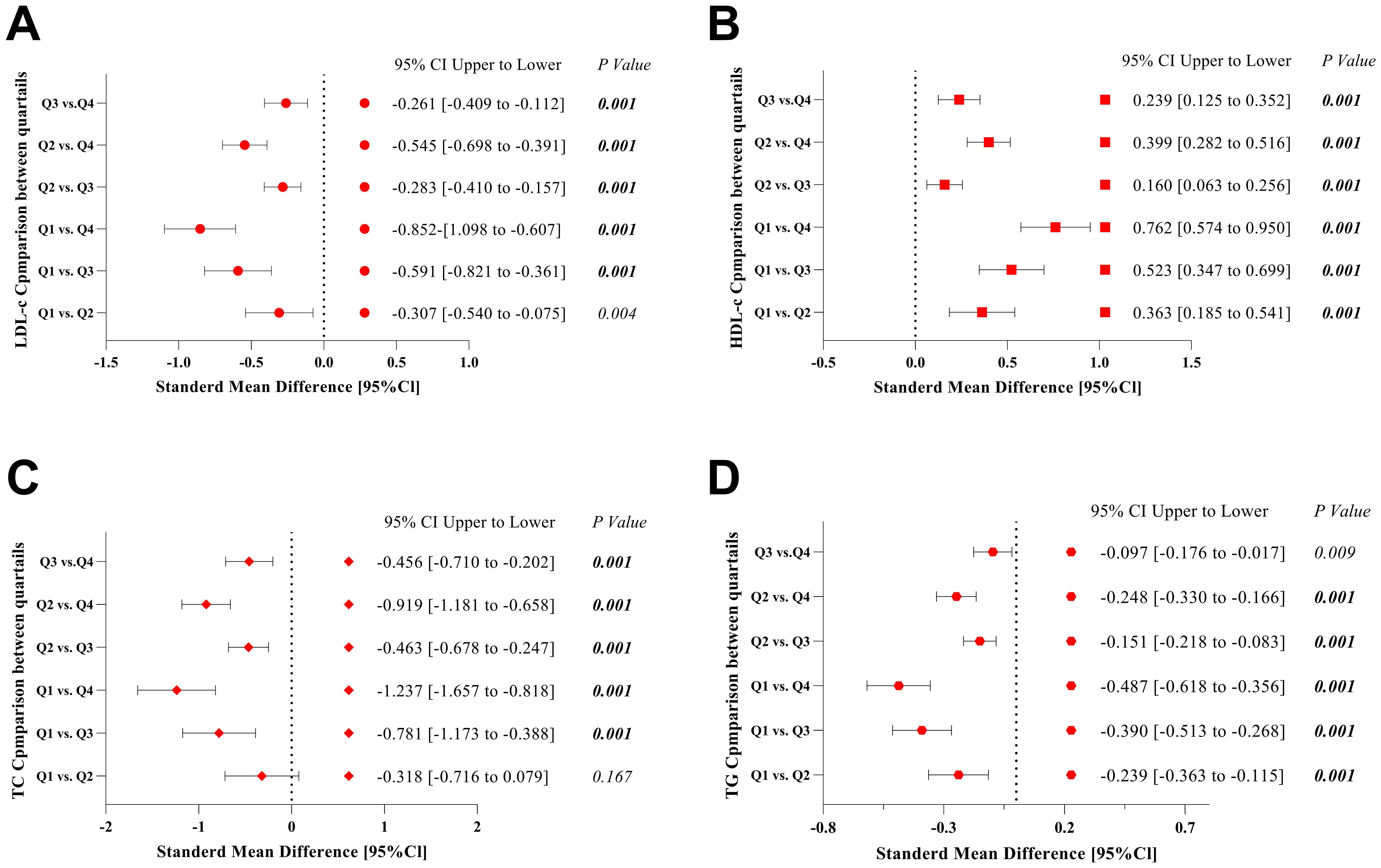
Figure 2. Forest plots of lipid profiles mean differences among the quartiles Q1-Q4. (A) Mean differences of LDL-c (B) Mean differences of HDL-c (C) Mean differences of TC (D) Mean differences of TG. Q1 serum uric acid [SUA] <230 µmol/L, Q2 SUA 231-280 µmol/L, Q3 SUA 281-343 µmol/L, Q4 SUA 344-400 µmol/L. TG, triglyceride; TC, total cholesterol; LDL-c, low-density lipoprotein cholesterol; HDL-c, high-density lipoprotein cholesterol, 95%CI, confidence intervals.
The analysis of HDL-c levels of Q1 vs. Q2, Q3, Q4 was significantly lower in Q1 compared to all other quartiles all (P< 0.001), with the largest difference between Q1 and Q4 mean difference (0.762, 95% CI [0.574 to 0.950], P<0.001). Q2 vs. Q3, Q4, in HDL-c continued to rise across quartiles, Q2 vs. Q4: mean difference (0.399, 95% CI [0.282 to 0.516], P<0.001). Q3 vs. Q4: A further increase was observed, mean difference (0.239, 95% CI [0.125 to 0.352], P<0.001) (Figure 2B). HDL-c levels exhibited a progressive increase from Q1 to Q4, suggesting that higher quartiles may have better cardioprotective lipid profiles.
The analysis of TC levels of Q1 vs. Q2 were not significant (P= 0.167). Q1 vs. Q3, Q4: TC was significantly lower in Q1 compared to Q3 with mean difference (-0.781, 95% CI [-1.173 to -0.388], P<0.001) and Q4 mean difference (-1.237, 95% CI [1.657 to -0.818], P<0.001). Q2 vs. Q3, Q4: TC increased significantly in higher quartiles Q2 vs. Q4: mean difference (-0.919, 95% CI [1.181 to -0.658], P< 0.001). Q3 vs. Q4: A significant but smaller difference was observed, mean difference (-0.456, 95% CI [-0.710 to -0.202], P< 0.001) (Figure 2C). TC levels were consistently higher in Q3 and Q4 compared to Q1 and Q2, except for the non-significant difference between Q1 and Q2. This suggests that TC may not discriminate well between the lowest two quartiles but is significantly elevated in higher-risk groups.
The analysis of TG of Q1 vs. Q2, Q3, Q4 were significantly lower in Q1 compared to all other quartiles (all P<0.05), with the largest difference between Q1 and Q4, mean difference (-0.487, 95% CI [-0.618 to -0.356], P<0.001). Q2 vs. Q3, Q4: TG continued to rise, Q2 vs. Q4 mean difference (-0.248, 95% CI [-0.330 to -0.166], P< 0.001). Q3 vs. Q4: A smaller but still significant increase was observed, mean difference (-0.097, 95% CI [-0.176 to -0.017], P=0.009) (Figure 2D). TG levels showed a clear stepwise increase from Q1 to Q4, reinforcing the association between higher quartiles and adverse lipid metabolism. These findings suggest that individuals in Q3 and Q4 may have an increased cardiovascular risk.
Association between SUA and lipid profiles
To investigate the correlation between SUA and lipid profiles in greater detail in our CKD population, we conducted a Spearman correlation and simple linear regression analysis within the CKD population. First, we divided the population into male and female groups to examine the association independently. Second, we conducted a comprehensive association analysis for all participants within the population. In the male group, TG, TC, and LDL-c showed a positive correlation with SUA with a statistically significant, correlation coefficient of (R=0.1797, R=0.2979, R=0.3553, respectively; P<0.0091 for TG and P<0.0001 for both TC and HDL-c) (Table 3, Figures 3A, B, D). However, HDL-c showed a negative correlation with SUA with a correlation coefficient of (R=-0.3445, P<0.0001) (Table 3, Figure 3C). Similarly, the female group showed a positive correlation between SUA and TG, TC, and LDL-c with a statistically significant, correlation coefficient of (R=0.5115, R=0.2741, R=0.5137 respectively, P<0.0004 for TC and P<0.0001 for both TG and LDL-c) (Table 3, Figures 4A, B, D). HDL-c also demonstrated a negative correlation with the SUA correlation coefficient of (R=-0.4055, P<0.0001) (Table 3, Figure 4C).
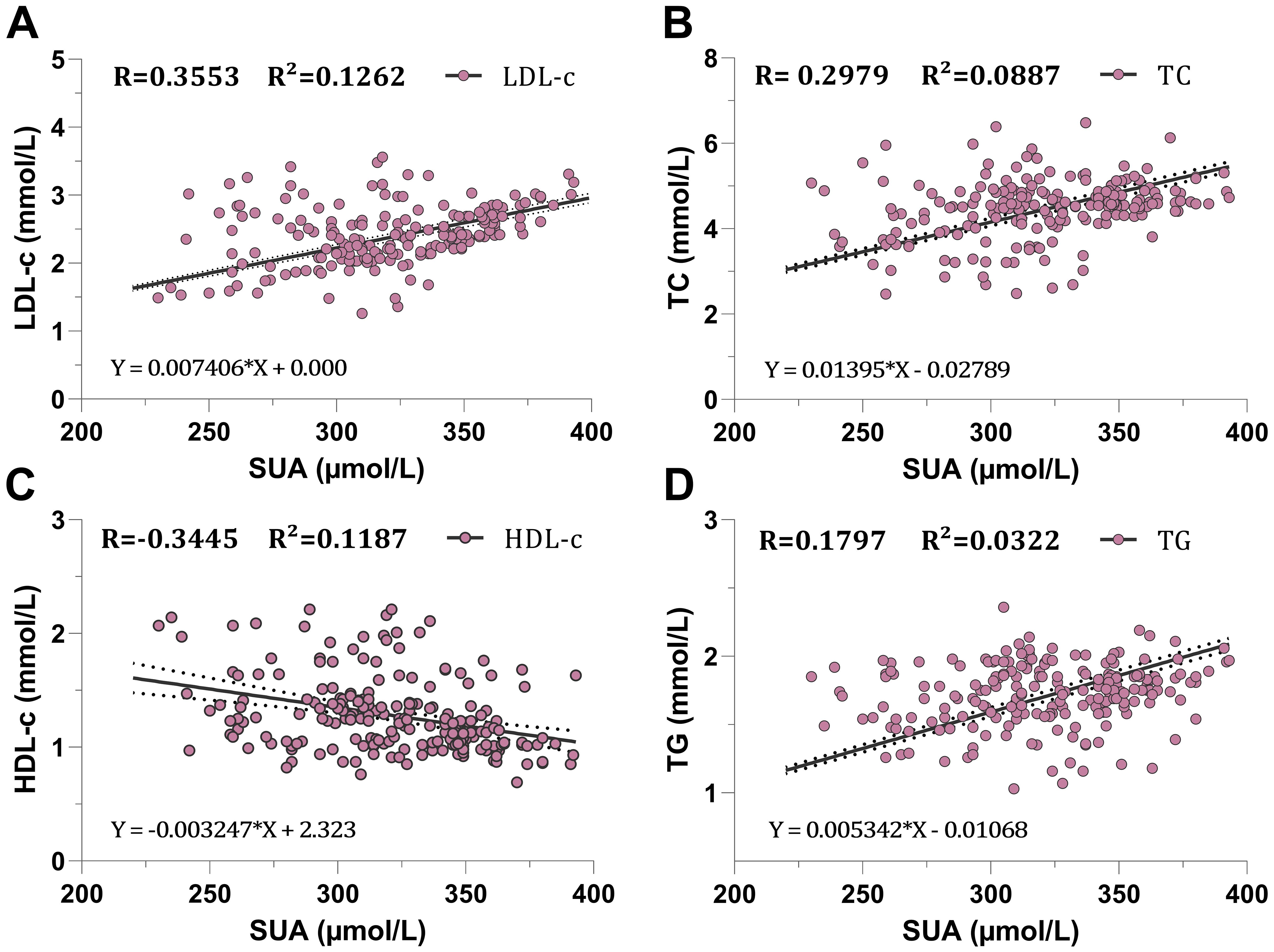
Figure 3. Scatter plot association between serum uric acid and lipid profiles in the male participants. (A) correlation with light-density lipoprotein cholesterol, (B) correlation with total cholesterol, (C) correlation with high-density lipoproteine cholesterol, (D) correlation with total triglyceride.

Figure 4. Scatter plot association between serum uric acid and lipid profiles in the male participants. (A) correlation with light-density lipoprotein cholesterol, (B) correlation with total cholesterol, (C) correlation with high-density lipoproteine cholesterol, (D) correlation with total triglyceride.
Comprehensively, Simple linear regression and Spearman correlation analyses revealed a positive correlation between SUA and LDL-c (R=0.5490, [95% CI: 0.4739 to 0.6161], P<0.001) (Figures 5A, E). Similarly, a positive correlation was found with TC and TG (R=0.4992, [95% CI: 0.4190 to 0.5717], P<0.001 for TC) (Figures 5B, E) and (R=0.4849, [95% CI: 0.4033 to 0.5588], P<0.001 for TG) (Figures 5D, E). While the analyses revealed an inverse correlation between SUA and HDL-c, (R=-0.5328, [95% CI: -0.6017 to -0.4560], P<0.001) (Figures 5C, E).
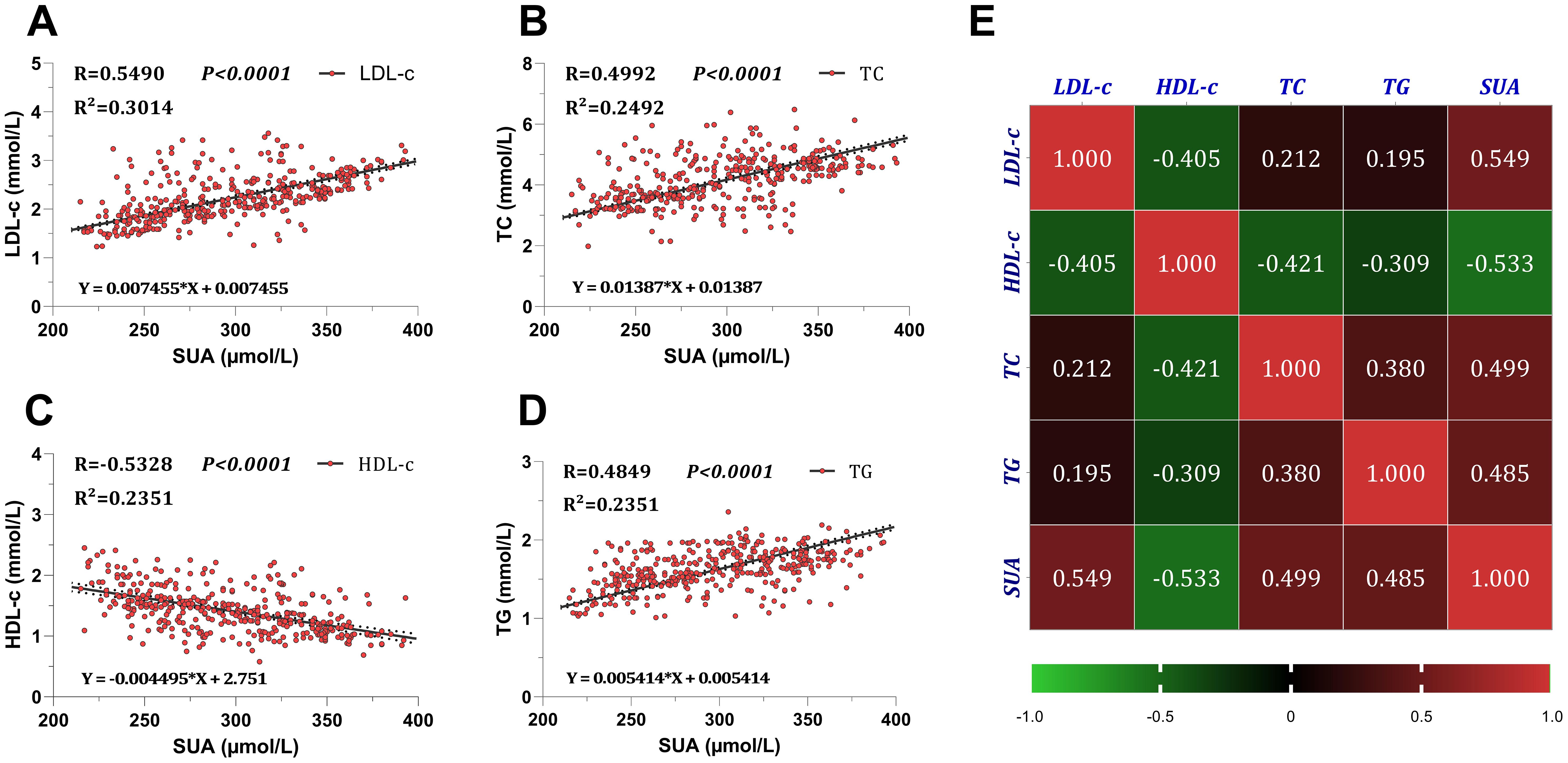
Figure 5. Association between serum uric acid and lipid profiles in the CKD population. (A) correlation with LDL-c light-density lipoprotein, (B) correlation with TC total cholesterol, (C) correlation with HDL-c high-density lipoprotein, (D) correlation with TG total triglyceride, (E) correlation matrix between SUA and lipids. Simple linear regression and Spearman correlation analyses were used to confirm the association between SUA and lipids. P<0.05 means statistical significance. SUA, serum uric acid; TG, total triglyceride; TC, total cholesterol; LDL-C, low density lipoprotein cholesterol; HDL-c, high density lipoprotein cholesterol.
The findings demonstrate a strong relationship between SUA and lipid profiles. An increase in the SUA levels may potentially increase LDL-c, TC, and TG while reducing HDL-c in the CKD population.
Effect size and parameter estimates for lipid profiles across quartiles
We conducted a multivariate analysis to determine the effect of SUA quartiles (Q1-Q4) on multiple dependent variables LDL-c, HDL-c, TC, and TG collectively. The test revealed a significant overall difference in lipid profiles across SUA quartiles. (Pillai’s Trace = 0.548, F=20.60, P<0.001), (Wilks’ Lambda = 0.468, F=26.88, P<0.001); (Hotelling’s Trace = 1.102, F= 33.58, P<0.001), (Roy’s Largest Root = 1.071, F= 98.76, P<0.001) (Table 4). Roy’s Largest Root, a conservative significance test, demonstrated the strongest effect (Partial η² = 0.517) with 51.7% of the variance in composite lipid outcomes explained by SUA quartiles. The multivariate tests demonstrated strong differences between quartiles (P<0.001 for all tests) with large to moderate effect sizes (Partial η² = 0.18 0.52). The results are consistent with systemic relationships between SUA levels and multivariate lipid patterns.
After establishing significant multivariate lipid profile differences among SUA quartiles, post-hoc univariate tests were conducted to resolve individual relationships. (Table 5) presents adjusted mean differences, confidence intervals, and effect sizes for all lipid variables relative to the highest SUA quartile (Q4, reference group). Post-hoc univariate tests revealed significant between-quartile differences for all lipid variables (all P ≤ 0.01). Relative to Q4, the lower quartiles of SUA (Q1–Q3) had progressively lower LDL-c, TC, and TG but higher HDL-c levels. The largest between-quartile differences were for LDL-c (Q1 vs. Q4: = -0.853, 95% CI [-1.040, -0.666]) and HDL-c (Q1 vs. Q4: = +0.763, 95% CI [0.620, 0.906]), with both effect sizes being large (Partial η² ≥ 0.18).
Characteristics of participants stratified according to age
To investigate the different characteristics of SUA and lipid profiles in the CKD population, we stratified the participants by age groups ranging from 20 to 80 (Table 6). Most participants were younger than 60 (35.81% men and 28.33% women). BMI showed an increasing trend with aging, with the lowest value (21.69 ± 1.33kg/m²) observed in the 20–29 age group and the highest value (27.19 ± 2.42kg/m²) seen in the ≥70 age group, which was statistically significant (P<0.001). SUA levels showed an increasing trend with aging in the CKD population, with the lowest value (286.00 ± 36.21 μmol/L) observed in the 20–29 age group, and the highest value (306.04 ± 38.97 μmol/L) was observed in the ≥70 age group with no statistically significant, (P<0.100). Interestingly, TG was also higher in the same age group, though this finding was not statistically significant, with a mean value of (1.68 ± 0.22 mmol/L), (P<0.092). LDL-c levels showed similar trending, increased with aging, reaching higher among patients aged ≥70 with a mean value of (2.45 ± 0.51 mmol/L) (P<0.001). HDL-c showed a reverse trend with aging, with the highest value among the young age group 20–29 compared to other age groups with a mean value of (1.57 ± 0.42 mmol/L) and the lowest value (1.37 ± 0.35 mmol/L) was observed in the ≥70 age group with statistically significant, (P<0.031). TC showed no significant difference among the age groups, although it was slightly higher among participants aged 60–69 with a mean value of (4.30 ± 0.72 mmol/L) and (P<0.112). eGFR level decreased with aging, being lowest in the ≥70 age group with a mean value of (38.68 ± 11.14 mL/min/1.73m²) and highest value in the 20–29 age group with a mean value of (45.85 ± 11.31 mL/min/1.73m²), which was statistically significant (P<0.028). Body weight increased with aging, being lowest in the 20–29 age group with a mean value of (62.70 ± 6.42 kg) and highest value in the ≥70 age group with a mean value of (73.02 ± 9.99 kg) which was statistically significant (P<0.001). For more details and other biomarkers, please refer to (Table 6).
Risk factors of SUA in the CKD population
In this section, we seek to investigate the predictors for SUA (dependent variable) in the CKD population on TC, TG, LDL-c, and HDL-c (independent variables). To achieve our results, we conducted multiple regression analyses, which are commonly used to assess the strength of the relationship between dependent and other independent variables. This method will allow us to predict how much variance is being accounted for in a single response of SUA by the set of independent variables. Given that we are examining more than three variables, multiple regressions are the most appropriate analytic approach.
The results of multiple linear regression analysis to predict SUA based on TG showed a coefficient (B=44.689, t=6.806). A significant regression was found, F (4,369) =114.554, (P<0.001). These results direct the positive effects of TG on SUA levels. Moreover, the R² value of 0.261 suggests that for each unit increase in TG, the levels of SUA increase by 26.1% see (Table 7). The results of TC were similar, indicating a coefficient (B=12.951, t=5.905), suggesting a positive correlation with SUA levels, with a significant regression found F (4,369) =114.554, (P<0.001). This result highlights a positive correlation between TC and SUA levels, where the R²=0.237 indicates that for each unit increase in TG, the levels of SUA levels increase by 23.7% see (Table 7). The regression results to predict SUA levels based on LDL-c were similar, revealing a coefficient of (B=33.454, t=9.562). A significant regression was found, F (4,369) =114.554, (P<0.001), emphasizing a positive relationship between LDL-c and SUA levels. Moreover, the R²=0.365 indicates that for each unit increase in LDL-c, the levels of SUA levels increase by 36.5% see (Table 7). Interestingly, the regression results for HDL-c revealed a negative correlation, with a coefficient B (-24.270, t=-4.939). This result indicates that HDL-c is inversely related to SUA levels; moreover, the R²=-205, means for every unit increase in HDL-c, SUA levels decrease by 20.5% see (Table 7). These results indicate robust evidence supporting the role of lipid profiles as risk factors for SUA in the CKD population.
To investigate various risk factors for SUA in both genders, four models were developed. Model one was adjusted for age, the results revealed a significant correlation with (R=0.176, P<0.010) for males, and (0.231, P<0.003) for females, respectively (Table 8). Model two included adjustment for age and BMI, resulting in a significant correlation of (R=0.211, P<0.009) in males, and (0.241, P<0.008) in females, respectively (Table 8). Model three was adjusted for age, BMI, and lipid profiles, the results revealed a significant difference with (R=0.549, P<0.001 and 0.654, P<0.001) in males and females, respectively (Table 8). Model four was adjusted for age, BMI, lipid profiles, and weight. The results indicated a significant correlation with (R=0.554, P<0.001 and R=0.654, P<0.001) in males and females, respectively (Table 8).
Discussion
This study reveals a positive correlation between SUA and atherogenic lipid profiles, specifically LDL-c, TC, and TG, in patients with CKD, while showing inverse relationships with HDL-c. Furthermore, a progressive increase in lipid parameters across the quartiles of SUA, particularly for TG, where the levels in the Q4 surpassed established clinical thresholds. These results establish SUA as both a biomarker and a potential mediator of dyslipidemia associated with CKD, carrying significant implications for the stratification of cardiovascular risk. This adds to a growing body of literature suggesting that SUA is crucial to metabolic dysregulation, especially in CKD individuals. This relationship presented with lipid profiles can be explained using varied pathophysiological mechanisms. Elevated levels of SUA could create oxidative stress and inflammation; both could affect the lipid metabolism process (30). SUA could also inhibit endothelial function and diminish lipoprotein lipase activity to generate a build-up of atherogenic lipids in patients with CKD. These effects are further intensified by renal insufficiency regarding the clearance of both SUA and lipids, which thus establishes an exacerbating cycle supporting the development of cardiovascular complications and the progression of CKD. The present study supports several earlier studies that have focused on the relationship of SUA with lipid metabolism in different populations. For instance, in a meta-analysis, Chen et al. (31) documented an association between SUA and dyslipidemia among Chinese adults with basic similarities in the elevation of LDL and TG; however, our study was conducted primarily on the CKD population, and to our knowledge, there are no studies conducted to evaluate this relationship in CKD populations which presents new insight and novelty to the field. Furthermore, Ahlawat M et al. (32) revealed a positive correlation between SUA and LDL-c in the hypertensive population, with a coefficient (R=0.269, P<0.007). Our results showed a close correlation between SUA and LDL-c with a coefficient (R=0.3553, P<0.0001 in men, and R=0.5137, P<0.0001 in women, respectively) indicating the close correlation between these markers in the CKD population. Similarly, TG and TC levels revealed similar results, indicating a close relationship with SUA. There are some important implications from our results; one is that HDL-c showed a significant inverse correlation with SUA in the CKD population, meaning any increase in the level of HDL-c could potentially decrease SUA levels, other implication is that the positive association between SUA and TG, LDL-c and TC, meaning any decrease in these markers could potentially decrease SUA levels in CKD population and vice versa, and thus could improve both HUA and slow the decline of renal function. Previous findings revealed a pathogenesis among HUA and dyslipidemia, although the populations are different but revealed similar results (14).
This strong correlation between SUA and lipid profiles among the CKD population has extensive clinical implications. This association suggests that SUA can be a potential modifiable risk factor for CVD in this specific population. HUA as an independent risk factor for mortality including CVD (33) and the fact that CVD is the leading cause of mortality in the CKD population, intervention for both SUA and lipid profile levels in the CKD population must be considered, which could have a positive impact on patient’s lives and outcomes among this population. Addressing SUA levels through dietary modifications or ULT could provide benefits in lipid correction, reducing cardiovascular risk and, in return, reducing the progression of CKD (12). Also highlighted by our results is the need for regular follow-up of both SUA and lipids in patients with CKD, particularly with the presence of more severe forms of the disease.
High SUA level, along with its complications such as metabolic syndrome and CVD, presents a major public health challenge globally. The high prevalence of these conditions, accompanied by serious health risks and great economic costs, has raised serious concerns in the public health community (34). Increased levels of SUA are often seen in CKD patients. This increase in SUA levels in CKD patients comes from a combination of renal impairment, metabolic abnormalities, dietary factors, and HTN (35–37). Strategic management of these risk factors through lifestyle changes, dietary modifications, and appropriate pharmacologic treatments, such as ULTs, can significantly mitigate the effects of HUA among CKD patients. Given these facts, SUA levels could act as a biomarker and as a modulator of lipid metabolism (38).
Our research reveals notable gender-specific associations between SUA levels and atherogenic lipid profiles, characterized by positive correlations between SUA and LDL-c/TC in males, and negative correlations between SUA and HDL-c in females. This stratification indicates a mechanistic difference: the more robust SUA-LDL-c relationship in males aligns with findings that HUA promotes hepatic lipogenesis through the activation of xanthine oxidase, while the dissociation of SUA and HDL-c in females may be indicative of estrogen deficiency exacerbating leptin resistance, which in turn hinders HDL-c synthesis. Nevertheless, significant differences arise within populations suffering from diabetic nephropathy. Kosekli MA et al. (39) found that elevated SUA levels were directly correlated with reduced eGFR and increased albuminuria in individuals with type 2 diabetic kidney disease (T2DKD), whereas our investigation excluded diabetic nephropathy due to the complications associated with comorbidities. This distinction is crucial, as the pathophysiology of SUA and lipids in diabetic CKD differs fundamentally from that in non-diabetic CKD.
In another study, Yang et al. (20) demonstrated metabolomic profiling in CKD patients with HUA, confirming these patterns transcend methodological and cohort differences. However, key distinctions arise: we excluded hyperuricemia to isolate non-diabetic pathophysiology, whereas Zhang et al. included both conditions, revealing diabetic cohorts exhibit attenuated SUA-lipid associations due to dominant glucotoxicity. Additionally, Zhou et al. (40) conducted a recent NHANES analysis that identified remnant cholesterol (RC) as a more robust predictor of HUA than conventional lipids (OR = 2.942 for Q4 RC) in the general adult population of the United States. This finding is consistent with our results regarding gender-specific patterns, where males show stronger correlations between SUA and LDL-c/RC, while females display a more significant dissociation between SUA and HDL-c. However, a notable methodological difference between our research and that of Zhou et al. is that we concentrated on non-dialysis CKD stages 1/4 without HUA or diabetic nephropathy, whereas Zhou et al. included individuals with HUA and diabetes, which may elucidate the nonlinear relationship they reported between RC and HUA.
From a methodological perspective, our prospective design enhances cross-sectional evidence, while the exclusion of dialysis patients elucidates the metabolic dynamics prior to ESKD. Nevertheless, subsequent studies ought to confirm these associations within diabetic CKD subgroups and investigate the combination therapy of urate-lowering agents and statins as a potential strategy, which is mechanistically underpinned by the synergies between serum uric acid SUA and lipid pathways.
Our study demonstrated that SUA correlated positively with age among the Chinese CKD population (Table 8), likely due to the decline in eGFR levels associated with aging and the presence of CKD. As kidney function declines, this will reduce the ability of the kidneys to excrete SUA and thus lead to accumulation in the blood (30). While some studies showed no correlation between age and SUA (41) this discrepancy could be attributed to the different populations studied, as our research specifically focuses on CKD patients. When adjusted to age and BMI, SUA demonstrated a strong correlation in the CKD population (Table 8), indicating that BMI is an independent predictor of SUA levels in CKD patients. This could be explained by higher BMI promoting HUA through mechanisms, including increased SUA production, decreased renal excretion of SUA, and systemic inflammation which can occur through promoting insulin resistance. Rathmann et al. (42) documented that BMI was significantly correlated with increasing SUA in all groups. Although the populations of these studies are different our results showed similar findings. Furthermore, when adjusted to lipid profiles, age, and BMI, SUA showed a significant positive association in Chinese CKD patients (Table 8). Several epidemiological studies have shown similar results in different population groups (43, 44). A combination of high LDL-c and low HDL-c worsens SUA levels, highlighting the link between metabolic syndrome and HUA in the context of CKD. With lifestyle modifications, some identified improvements to diet, and pharmacotherapy (45), SUA levels may be regulated to positively influence the health outcomes of CKD patients, controlling SUA in critical for preserving kidney function in non-dialysis CKD population.
Limitations
While this investigation provides insight and evidence on the correlation of SUA with lipid profiles in the CKD population, certain limitations do need to be stated. First, the study’s observational cross-sectional design inherently restricts the ability to establish causal relationships between SUA levels and lipid profiles, as it only captures associations at a single time point. Second, the study may be subject to selection bias, as the sample population was derived from one city, potentially limiting generalizability to broader CKD populations. Additionally, although we adjusted for key demographic and clinical confounders age, BMI, confounding from unmeasured factors like dietary patterns, genetic polymorphisms in urate transporters, or environmental exposures may persist. Future studies should incorporate comprehensive nutritional assessments, genomic profiling, and physical activity metrics to further refine these relationships. Furthermore, the absence of diabetic nephropathy and HUA patients also limits generalizability, insulin resistance which can significantly influences both SUA and lipid levels were not accounted for and the use of medications such as diuretics, ACE and CCB all which can impact SUA levels and lipid profiles, we deliberately refrained from adjusting for these agents in our statistical models. These drugs are preferentially prescribed to patients with HTN, proteinuria, or advanced CKD conditions intrinsically linked to both SUA elevation and dyslipidemia, statistical adjustment would introduce indication bias, potentially obscuring true biological relationships by correcting for clinical features central to CKD pathophysiology. Consequently, our reported SUA-lipid associations reflect real-world clinical phenotypes.
Conclusion
The study reveals a significant association between SUA levels and lipid profiles in CKD patients, highlighting a positive correlation with atherogenic lipids LDL-c, TC, and TG and an inverse relationship with cardioprotective lipid HDL-c. SUA quartiles could effectively stratified dyslipidеmia risk, supporting its utility as a biomarker. These findings reveal gender-specific SUA-lipid pathways that may inform personalized cardiovascular risk management in CKD. Notably, lipid profiles were identified as independent predictors for SUA levels in the CKD population. This adds a new dimension to understanding the SUA role in CKD-related dyslipidemia.
Data availability statement
The raw data supporting the conclusions of this article will be made available by the authors, without undue reservation.
Ethics statement
The studies involving humans were approved by scientific research ethics committees of all participating hospitals, the Faculty of Nephrology, Xuzhou Medical University, with project ethics numbers (XYFY2024-KL642-01) and Department of Nephrology, Fengxian People’s Hospital (LLSC-2025-001) and Department of Nephrology, the Second Affiliated Hospital of Xuzhou Medical University ([2025] 030501). This study is part of a broader research project titled 'Assessment of lipid profiles correlation with serum uric acid in non-dialysis dependent chronic kidney disease patients and the effects of urate-lowering therapy on lipids'. All procedures adhere to the ethical standards outlined in the approved protocol. The studies were conducted in accordance with the local legislation and institutional requirements. The participants provided their written informed consent to participate in this study.
Author contributions
YW: Data curation, Formal Analysis, Methodology, Software, Visualization, Writing – original draft, Writing – review & editing. HY: Data curation, Formal Analysis, Investigation, Supervision, Writing – review & editing. JL: Data curation, Formal Analysis, Investigation, Supervision, Writing – review & editing. SA: Writing – review & editing. MB: Writing – review & editing. KS: Writing – review & editing. SF: Writing – review & editing. SL: Funding acquisition, Investigation, Supervision, Writing – review & editing. YW: Funding acquisition, Investigation, Supervision, Writing – review & editing. DW: Investigation, Supervision, Writing – review & editing. XZ: Investigation, Supervision, Writing – review & editing. DS: Funding acquisition, Investigation, Project administration, Resources, Supervision, Writing – review & editing.
Funding
The author(s) declare that financial support was received for the research and/or publication of this article. This study was supported by funding from the National Natural Science Foundation of China (82470726, 82270731, 82000703); the Jiangsu Provincial Natural Science Foundation (BK20211054); Science and technology development fund of Affiliated Hospital of Xuzhou Medical University (XYFC2020001; XYFY2020038); The High-Level Hospital Construction Project of Jiangsu Province (LCZX202403); Paired Assistance Scientific Research Project by The Affiliated Hospital of Xuzhou Medical University (SHJDBF2024104);Xuzhou Basic Research Program (KC22042); The Open Project of Key Laboratory of Higher Education Institutions in Jiangsu Province (XZSYSKF2023019) Xuzhou Medical leading Talent training Project (XWRCHT20210038);Beanstalk talent of Affiliated Hospital of Xuzhou Medical University; the New Technology project of Affiliated Hospital of Xuzhou Medical University (2020301018), Affiliated Hospital of Xuzhou Medical University Research Program (2023ZL20).
Acknowledgments
We would like to express our gratitude to Xuzhou Medical University and The Affiliated Hospital of Xuzhou Medical University and the participating hospitals for allowing us to conduct the current research. It’s a true honor to have received such a valuable opportunity.
Conflict of interest
The authors declare that the research was conducted in the absence of any commercial or financial relationships that could be construed as a potential conflict of interest.
Generative AI statement
The author(s) declare that no Generative AI was used in the creation of this manuscript.
Publisher’s note
All claims expressed in this article are solely those of the authors and do not necessarily represent those of their affiliated organizations, or those of the publisher, the editors and the reviewers. Any product that may be evaluated in this article, or claim that may be made by its manufacturer, is not guaranteed or endorsed by the publisher.
Abbreviations
BMI, Body Mass Index; BUN, Blood Urea Nitrogen; C-cys , Cystin C; CK, Creatine Kinase; CKD, Chronic Kidney Disease; CK-MB, Creatine Kinase MB; CVD, Cardiovascular Disease; eGFR, Estimated Glomerular Filtration Rate; ESKD, End-Stage Kidney Disease ; FBG, Fasting Blood Glucose ; HDL-c, High-Density Lipoprotein; Hs-CRP, High Sensitivity-C reactive Protein ; HTN, Hypertension; HUA, Hyperuricemia; LDL-c, Low-Density Lipoprotein Cholesterol; LVEDD, Left Ventricular End-Diastolic Dimension; LVEF , Left Ventricular Ejection Fraction; LVPW, Left Ventricular Posterior Wall; OS, Oxidative Stress; Scr, Serum Creatinine; TC, Total Cholesterol; TG, Triglyceride; SUA, Serum Uric Acid; ULT, Urate Lowering Therapy; XO, Xanthine Oxidase.
References
1. Fiorentino TV, Sesti F, Succurro E, Pedace E, Andreozzi F, Sciacqua A, et al. Higher serum levels of uric acid are associated with a reduced insulin clearance in non-diabetic individuals. Acta Diabetol. (2018) 55:835–42. doi: 10.1007/s00592-018-1153-8
2. Waheed YA, Liu J, Almayahe S, and Sun D. The role of hyperuricemia in the progression of end-stage kidney disease and its molecular prospective in inflammation and cardiovascular diseases: A general review. Ther Apheresis Dialysis. (2025). doi: 10.1111/1744-9987.70000. Advance online publication.
3. Waheed Y, Yang F, and Sun D. Role of asymptomatic hyperuricemia in the progression of chronic kidney disease and cardiovascular disease. Korean J Internal Med. (2021) 36:1281–93. doi: 10.3904/kjim.2020.340
4. Jakše B, Jakše B, Pajek M, and Pajek J. Uric acid and plant-based nutrition. Nutrients. (2019) 11:1736. doi: 10.3390/nu11081736
5. Chinese Society of Endocrinology. Guidelines for the diagnosis and management of hyperuricemia and gout in China (2019). Chin J Endocrinol Metab. (2020) 2020:1–13. doi: 10.3760/cma.j.issn.1000-6699.2020.01.001
6. Liu R, Han C, Wu D, Xia X, Gu J, Guan H, et al. Prevalence of hyperuricemia and gout in mainland China from 2000 to 2014: A systematic review and meta-analysis. BioMed Res Int. (2015) 2015:762820. doi: 10.1155/2015/762820
7. Choi HK, Mount DB, Reginato AM, American college of physicians, and American physiological society. Pathogenesis of gout. Ann Intern Med. (2005) 143:499–516. doi: 10.7326/0003-4819-143-7-200510040-00009
8. Carbone A, Al Salhi Y, Tasca A, Palleschi G, Fuschi A, De Nunzio C, et al. Obesity and kidney stone disease: a systematic review. Minerva Urol Nefrol. (2018) 70:393–400. doi: 10.23736/S0393-2249.18.03113-2
9. Richette P, Perez-Ruiz F, Doherty M, Jansen TL, Nuki G, Pascual E, et al. Improving cardiovascular and renal outcomes in gout: what should we target? Nat Rev Rheumatol. (2014) 10:654–61. doi: 10.1038/nrrheum.2014.124
10. Ohno I. Relationship between hyperuricemia and chronic kidney disease. Nucleosides Nucleotides Nucleic Acids. (2011) 30:1039–44. doi: 10.1080/15257770.2011.611484
11. Yuan H, Yu C, Li X, Sun L, Zhu X, Zhao C, et al. Serum uric acid levels and risk of metabolic syndrome: A dose-response meta-analysis of prospective studies. J Clin Endocrinol Metab. (2015) 100:4198–207. doi: 10.1210/jc.2015-2527
12. Lippi G, Montagnana M, Luca Salvagno G, Targher G, and Cesare Guidi G. Epidemiological association between uric acid concentration in plasma, lipoprotein (a), and the traditional lipid profile. Clin Cardiol. (2010) 33:E76–80. doi: 10.1002/clc.20511
13. Ali N, Rahman S, Islam S, Haque T, Molla NH, Sumon AH, et al. The relationship between serum uric acid and lipid profile in Bangladeshi adults. BMC Cardiovasc Disord. (2019) 19:42. doi: 10.1186/s12872-019-1026-2
14. Peng TC, Wang CC, Kao TW, Chan JY, Yang YH, Chang YW, et al. Relationship between hyperuricemia and lipid profiles in US adults. BioMed Res Int. (2015) 2015:127596. doi: 10.1155/2015/127596
15. Keenan T, Blaha MJ, Nasir K, Silverman MG, Tota-Maharaj R, Carvalho JA, et al. Relation of uric acid to serum levels of high-sensitivity C-reactive protein, triglycerides, and high-density lipoprotein cholesterol and to hepatic steatosis. Am J Cardiol. (2012) 110:1787–92. doi: 10.1016/j.amjcard.2012.08.012
16. Li L, Song Q, and Yang X. Lack of associations between elevated serum uric acid and components of metabolic syndrome such as hypertension, dyslipidemia, and T2DM in overweight and obese Chinese adults. J Diabetes Res. (2019) 2019:3175418. doi: 10.1155/2019/3175418
17. Lucio-Gutiérrez JR, Cordero-Pérez P, Ávila-Velázquez JL, Torres-González L, Farías-Navarro IC, Govea-Torres G, et al. Targeted and untargeted serum NMR metabolomics to reveal initial kidney disease in diabetes mellitus. J Pharm Biomed Anal. (2024) 247:116240. doi: 10.1016/j.jpba.2024.116240
18. Wang H, Jin X, Lin F, Chen G, Lin M, and Ma Y. Sex-specific and metabolic subgroup heterogeneity in high-density lipoprotein cholesterol associations with diabetic kidney disease risk: a retrospective cohort study. Lipids Health Dis. (2025) 24:205. doi: 10.1186/s12944-025-02632-4
19. Yoshitomi R, Fukui A, Nakayama M, Ura Y, Ikeda H, Oniki H, et al. Sex differences in the association between serum uric acid levels and cardiac hypertrophy in patients with chronic kidney disease. Hypertens Res: Off J Japanese Soc Hypertens. (2014) 37:246–52. doi: 10.1038/hr.2013.134
20. Yang WY, Wang J, Li XH, Xu B, Yang YW, Yu L, et al. Analysis of non-targeted serum metabolomics in patients with chronic kidney disease and hyperuricemia. Biotechnol Genet Eng Rev. (2024) 40:4013–39. doi: 10.1080/02648725.2023.2204715
21. Levin A, Stevens P, Bilous RW, Coresh J, Francisco A, Jong PE, et al. Kidney disease: Improving global outcomes (KDIGO) CKD work group. KDIGO 2012 clinical practice guideline for the evaluation and management of chronic kidney disease. Kidney International Supplements. (2013) 3:1–150. doi: 10.1038/kisup.2012.73
22. Machin D, Campbell MJ, Tan SB, and Tan SH. Sample size tables for clinical studies Third Edition. (2011), 10.1002/9781444300710.ch3.
23. Inker LA, Schmid CH, Tighiouart H, Eckfeldt JH, Feldman HI, Greene T, et al. Estimating glomerular filtration rate from serum creatinine and cystatin C. N Engl J Med. (2012) 367:20–9. doi: 10.1056/NEJMoa1114248
24. Fang J and Alderman MH. Serum uric acid and cardiovascular mortality the NHANES I epidemiologic follow-up study, 1971-1992. National Health and Nutrition Examination Survey. JAMA. (2000) 283:2404–10. doi: 10.1001/jama.283.18.2404
25. Kuwabara M. Hyperuricemia, cardiovascular disease, and hypertension. Pulse (Basel). (2016) 3:242–52. doi: 10.1159/000443769
26. Bloomgarden Z and Ning G. Journal of diabetes: ushering in volume 10. J Diabetes. (2018) 10:4–5. doi: 10.1111/1753-0407.12609
27. Ostchega Y, Hughes JP, Zhang G, Nwankwo T, Graber J, and Nguyen DT. Differences in hypertension prevalence and hypertension control by urbanization among adults in the United States, 2013-2018. Am J Hypertens. (2022) 35:31–41. doi: 10.1093/ajh/hpab067
28. Rychik J, Ayres N, Cuneo B, Gotteiner N, Hornberger L, Spevak PJ, et al. American Society of Echocardiography guidelines and standards for performance of the fetal echocardiogram. J Am Soc Echocardiogr. (2004) 17:803–10. doi: 10.1016/j.echo.2004.04.011
29. Lang RM, Bierig M, Devereux RB, Flachskampf FA, Foster E, Pellikka PA, et al. Recommendations for chamber quantification: a report from the American Society of Echocardiography’s Guidelines and Standards Committee and the Chamber Quantification Writing Group, developed in conjunction with the European Association of Echocardiography, a branch of the European Society of Cardiology. J Am Soc Echocardiogr. (2005) 18:1440–63. doi: 10.1016/j.echo.2005.10.005
30. Johnson RJ, Nakagawa T, Jalal D, Sánchez-Lozada LG, Kang DH, and Ritz E. Uric acid and chronic kidney disease: which is chasing which? Nephrol Dial Transplant. (2013) 28:2221–8. doi: 10.1093/ndt/gft029
31. Chen S, Yang H, Chen Y, Wang J, Xu L, Miao M, et al. Association between serum uric acid levels and dyslipidemia in Chinese adults: A cross-sectional study and further meta-analysis. Med (Baltimore). (2020) 99:e19088. doi: 10.1097/MD.0000000000019088
32. Ahlawat M, Shivnitwar S, Borle A, Ande SP, and Raut S. A study of lipid profile and the correlation of serum uric acid levels in patients with hypertension. Cureus. (2024) 16:e62952. doi: 10.7759/cureus.62952
33. Chen JH, Chuang SY, Chen HJ, Yeh WT, and Pan WH. Serum uric acid level as an independent risk factor for all-cause, cardiovascular, and ischemic stroke mortality: a Chinese cohort study. Arthritis Rheumatol. (2009) 61:225–32. doi: 10.1002/art.24164
34. Chen MY, Zhao CC, Li TT, Zhu Y, Yu TP, Bao YQ, et al. Serum uric acid levels are associated with obesity but not cardio-cerebrovascular events in Chinese inpatients with type 2 diabetes. Sci Rep. (2017) 7:40009. doi: 10.1038/srep40009
35. See LC, Kuo CF, Chuang FH, Shen YM, Ko YS, Chen YM, et al. Hyperuricemia and metabolic syndrome: associations with chronic kidney disease. Clin Rheumatol. (2011) 30:323–30. doi: 10.1007/s10067-010-1461-z
36. Choi HK, Willett W, and Curhan G. Fructose-rich beverages and risk of gout in women. JAMA. (2010) 304:2270–8. doi: 10.1001/jama.2010.1638
37. Krishnan E, Pandya BJ, Chung L, and Dabbous O. Hyperuricemia and the risk for subclinical coronary atherosclerosis–data from a prospective observational cohort study. Arthritis Res Ther. (2011) 13:R66. doi: 10.1186/ar3322
38. Lima WG, Martins-Santos ME, and Chaves VE. Uric acid is a modulator of glucose and lipid metabolism. Biochimie. (2015) :116:17–23. doi: 10.1016/j.biochi.2015.06.025
39. Kosekli MA and Aktas G. Serum uric acid to hdl cholesterol ratio is associated with diabetic control in new onset type 2 diabetic population. Acta Clin Croat. (2023) 62:277–82. doi: 10.20471/acc.2023.62.02.04
40. Zhou X, Weng X, Xu J, and Wang W. Correlation between remnant cholesterol and hyperuricemia in American adults. Lipids Health Dis. (2024) 23:176. doi: 10.1186/s12944-024-02167-0
41. Liang J, Jiang Y, Huang Y, Song W, Li X, Huang Y, et al. The comparison of dyslipidemia and serum uric acid in patients with gout and asymptomatic hyperuricemia: a cross-sectional study. Lipids Health Dis. (2020) 19:31. doi: 10.1186/s12944-020-1197-y
42. Rathmann W, Haastert B, Icks A, Giani G, and Roseman JM. Ten-year change in serum uric acid and its relation to changes in other metabolic risk factors in young black and white adults: the CARDIA study. Eur J Epidemiol. (2007) 22:439–45. doi: 10.1007/s10654-007-9132-3
43. Duan Y, Liang W, Zhu L, Zhang T, Wang L, Nie Z, et al. Association between serum uric acid levels and obesity among university students (China). Nutr Hosp. (2015) 31:2407–11. doi: 10.3305/nh.2015.31.6.8734
44. Jaipakdee J, Jiamjarasrangsri W, Lohsoonthorn V, and Lertmaharit S. Prevalence of metabolic syndrome and its association with serum uric acid levels in Bangkok Thailand. Southeast Asian J Trop Med Public Health. (2013) 44:512–22.
45. Waheed YA, Yang F, Liu J, Almayahe S, Selvam KKM, Wang D, et al. Efficacy of febuxostat on hyperuricemia and estimated glomerular filtration rate in patients with non-dialysis stage 3/4 chronic kidney disease and assessment of cardiac function: a 12-month interventional study. Front Nephrol. (2025) 5:1526182. doi: 10.3389/fneph.2025.1526182
Keywords: serum uric acid, chronic kidney disease, dyslipidemia, hyperuricemia, cardiovascular risk
Citation: Waheed YA, Yin H, Liu J, Almayahe S, Bishdary M, Munisamy Selvam KK, Farrukh SM, Li S, Wang Y, Wang D, Zhou X and Sun D (2025) Gender-specific assessment of lipid profiles correlation with serum uric acid in non-dialysis chronic kidney disease patients: Prospective observational cross-sectional study. Front. Endocrinol. 16:1641978. doi: 10.3389/fendo.2025.1641978
Received: 05 June 2025; Accepted: 10 July 2025;
Published: 30 July 2025.
Edited by:
Fernando Cardona, Spanish National Research Council (CSIC), SpainReviewed by:
Chonin Cheang, Macau Society for Health Economics, Macao SAR, ChinaQiming Xu, Seventh People’s Hospital of Shanghai, China
Leilei Guo, Jiang You People’s Hospital, China
Copyright © 2025 Waheed, Yin, Liu, Almayahe, Bishdary, Munisamy Selvam, Farrukh, Li, Wang, Wang, Zhou and Sun. This is an open-access article distributed under the terms of the Creative Commons Attribution License (CC BY). The use, distribution or reproduction in other forums is permitted, provided the original author(s) and the copyright owner(s) are credited and that the original publication in this journal is cited, in accordance with accepted academic practice. No use, distribution or reproduction is permitted which does not comply with these terms.
*Correspondence: Xinglei Zhou, ZHpob3V4aW5nbGVpQDE2My5jb20=; Dong Sun, c3VuZG9uZ3h6QDEyNi5jb20=
†ORCID: Yousuf Abdulkarim Waheed, orcid.org/0000-0003-0235-4171
Dong Sun, orcid.org/0000-0002-4546-404X
 Yousuf Abdulkarim Waheed
Yousuf Abdulkarim Waheed Huanhuan Yin
Huanhuan Yin Jie Liu4
Jie Liu4 Karthick Kumaran Munisamy Selvam
Karthick Kumaran Munisamy Selvam Xinglei Zhou
Xinglei Zhou Dong Sun
Dong Sun